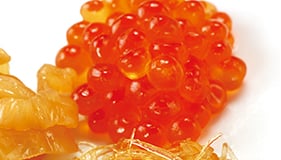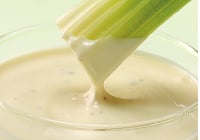Calcium Alginate
PrintCharacteristic
Uronic acid, which is a constituent sugar of alginic acid, has one carboxyl group per unit with a high ion exchange property. Binding with various cations generates unique alginate salts.
Calcium alginate is a salt in which calcium ions are bonded to the carboxyl group of alginic acid. Calcium ion, because it is a divalent cation, links (ion bridges) between two carboxyl groups. As a result, calcium alginate, unlike other alginates, is insoluble in water.
 Calcium alginate itself is not often used in foods. However, when sodium alginate is used as a gelling agent, the gel formed by the addition of a calcium salt contains calcium alginate.
Calcium alginate itself is not often used in foods. However, when sodium alginate is used as a gelling agent, the gel formed by the addition of a calcium salt contains calcium alginate.
Therefore, in foods using the gelling ability of alginic acid, such as artificial salmon roe and onion rings, calcium alginate is indirectly used.
Application
Food Applications

A solution which comprises of a mix of sodium alginate with calcium alginate becomes a thixotropic non-Newtonian fluid.
It is suitable for dipping sauces which require viscosity without stringing.
Effect on Bioactivity
Calcium alginate has an effect within the body prior to discharge, similar to sodium alginate.
Selection Guide (Typical Products)
KIMICA ALGIN Ca
Products listed above are typical grades only and other grades are available.
Appropriate products would be proposed after consultation.
Documents
Inquiries about the products